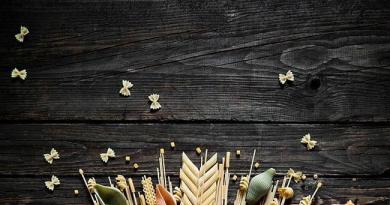The term "engraving" includes all methods of manual processing of wood, metal or stone surfaces for printing from a vice. In accordance with what part of the board is covered with paint during printing, that is, it turns out to be printing, three types of engraving are distinguished: raised engraving (wood engraving, or woodcut, linoleum engraving and relief engraving on metal), in-depth engraving ra (all other types of metal engraving) and flat engraving (lithography and its varieties).
Convex engraving
Woodcut. The oldest engraving technique appeared in the East, the earliest of the prints on paper is dated 868. Appears in Europe at the turn of the 14th - 15th centuries; the first dated woodcut dates back to 1418. Until the end of the 18th century, only edged, or longitudinal, woodcuts existed. A flat polished board (cherry, pear, apple wood), certainly longitudinally cut along the grain of the wood, is primed, a drawing is applied on top of the primer with a pen, then the lines on both sides are cut off with sharp knives, and the wood between lines are selected with a special chisel to the depth G- 5 millimeters. When printing, paint is applied (first with tampons, later with a roller) on the convex part of the board, a sheet of paper is placed on it and pressed evenly - with a press or by hand, in this way the image from the board is transferred to the paper. In cut engraving, the composition turns out to be a combination of black lines and contrasting spots.
In the last quarter of the 18th century, the Englishman T. Bewick introduced the method end-face, or transverse, woodcut, in which the board is sawn across the trunk, so that the fibers of the tree run perpendicular to the surface of the board. When woodcutting is done, dense wood is used (beech, boxwood) and cut with a special cutter - a gravel, the trace of which gives a white line in the print. Edge woodcut allows you to work with a thinner stroke, the varying degrees of saturation of which allow you to vary the tone. Woodcut yields 1500 - 2000 good prints.
Relief engravingon metal. It was used only until the beginning of the 15th century. A plate made of copper, brass, tin or lead is processed with special cutters so that as a result of engraving it becomes similar to a cut woodcut board; is printed as the last one.
Engraving on linoleum. It arose at the turn of the 19th - 20th centuries. Linoleum is processed with cutters that look like small curved chisels, just as in cut woodcuts. The paint is rolled with a roller and printed like a woodcut. Engraving on linoleum gives about 500 good impressions.
In-depth engraving
In a metal plate (copper, brass, zinc, iron), a pattern in the form of combinations of lines and dots is deepened by mechanical or chemical methods. Then paint is driven into the recesses with tampons, the board is covered with damp paper and rolled between the rollers of the printing press. The main types of in-depth engraving on metal:
Chisel engraving.
Appeared in the first quarter of the 15th century. The first dated chisel engraving dates back to 1446. The design is cut into a metal board with a square steel cutter with a diamond-shaped cut. This method allows you to work only with combinations of pure lines. Engraving with a chisel produces up to 1000 impressions.
Etching.
It arose at the beginning of the 16th century. The first dated engraving dates back to 1513. The board is coated with acid-resistant varnish, the design is scratched into the varnish with a needle, exposing the surface of the metal. After immersing the board in acid, the design is etched into the metal. Etching gives about 500 from a vice.
Drypoint engraving. The copper board is scratched directly with an etching needle, without varnishing or etching. When printing, ink gets stuck in scratches and burrs (“barbs”). Drypoint engraving produces up to 100 impressions.
Dotted style. It appeared as an independent technique in England in the second half of the 18th century. A pattern consisting of a combination of condensed or sparse dots is applied to a varnished board with special needles and tape measures, then the board is etched. Sometimes varnish and etching are not used: the design is stamped out with special punches.
A special type of dotted style is the pencil style, invented in the middle of the 18th century. The stroke in this technique consists of individual dots etched in metal, imitating the mark of a chalk pencil or sanguine. Dotted engraving produces about 500 impressions.
Soft varnish. The technique originated in the 18th century. The board is varnished with a strong addition of lard. Rough paper is placed on it and a design is applied, then the paper is removed along with the adhering pieces of varnish, exposing the surface of the board. After etching and printing, the print reproduces the texture of the paper.
Aquatint. Invented in France in the middle of the 18th century for reproducing a tone drawing in ink in engraving. With this technique, a heated board is evenly coated with a resinous powder, the individual grains of which stick to the warm metal and to each other. During etching, the acid penetrates only into the pores between the powder particles, leaving a mark on the board in the form of a mass of individual pinpoint depressions. Those places that should be darker on the print are etched longer, light areas after short-term etching are covered with liquid varnish. Aquatint produces from 500 to 10oo prints.
Lavis. A metal brush with a strong acid is used to paint directly on the board, which, due to the graininess of the metal, is etched unevenly, which in turn gives the print a tone of varying strength. Lavis gives several dozen prints.
Mezzotint, or black manner. Engraving was first made using this technique in 1642. Using a special tool - a “rocker”, numerous indentations are applied to the board so that it acquires a uniform roughness, and when printing, a thick, velvety tone is obtained. The drawing on the board prepared in this way is smoothed and sanded with a “smoothing iron”, and the more the board is smoothed, the weaker the paint sticks to it, and in the print these places turn out to be lighter. Mezzotint yields about 200 ot-vises.
Flat engraving
Technique lithographs invented in 1796 in Germany by A. Zenefelder. Lithography takes advantage of the ability of some limestone rocks not to accept paint after etching with a weak acid. The process of working with nal lithography is as follows: a limestone plate is smoothed, polished or made uniformly rough (this texture is called “corn” or “spine”). On a stone prepared in this way, they do not draw with a special pencil or pen and brush, using lithographic ink. A stone with a completed design is etched with a mixture of acid and gum arabic. As a result of etching, the areas covered with the pattern easily accept printing ink; the clean surfaces of the stone repel it. The board is coated with paint using a roller and printed in a machine on thick paper. Sometimes, instead of limestone, specially prepared zinc or aluminum plates are used. Often they draw with a lithographic pencil or ink not on stone, but on special, so-called autograph or transfer paper, after which the drawing is pressed onto the stone. The entire subsequent process is the same as in classical lithography. Lithography will produce several thousand prints.
Color engraving
Color engraving is produced in two different ways. In the first case, paint of different colors is applied to one board using tampons, after which the board is printed. With this method, the color in the engraving turns out to be approximate and each print differs from the other.
Another way is to use a separate board for each color or tone, which is processed only in the appropriate places. These boards, each coated with its own paint, are sequentially printed on one sheet of paper.
One of the varieties of color engraving is chiaroscuro- a woodcut technique that developed mainly in the 16th century. Each board differs from the other not only in color, but also in shade of tone, and most often only part of the composition is cut out on each board: the entire composition appears on the print only as a result of printing from all the boards.
State. The stage of the engraver’s work on the board, fixed in the impression, is called “state.” Some artists, especially etchers, know up to twenty states of one engraving.
The article is taken from the book "Essays on the history and technology of engraving", Moscow, " art" 1987
Any painting made of metal using such a difficult technique becomes a real work of art. Even the smallest, skillfully executed details of the engravings fascinate with their perfection and beauty.
Product range
- A special place in graphic art is occupied by the production of engravings on religious themes (icons and biblical scenes).
- Metal products depicting great figures and historical events are no less magnificent.
- Copies of paintings by famous artists will decorate any interior.
- Classic still lifes, natural landscapes, animals and much more are perfect as a gift.
Metal is a cold material, but the images created on such an unusual canvas enliven the space, filling it with warmth. Talented gift engravings will add the finishing touch to your interior design and become a kind of... business card owner of an apartment, house or office.
An unusual reproduction will take its rightful place in the collection of connoisseurs contemporary art. Our craftsmen will make custom engravings for you based on individual sketches or based on ready-made layouts, supplemented with exclusive elements.
How to place an order
You can buy engravings by calling:
Metal engraving as an art form arose during the Renaissance. Many famous artists worked in the engraving technique. Works are known not only on plates, but also on daggers, swords, and bracelets. There are many techniques, each with its own aesthetics and language.
Today, metal engraving is experiencing a rebirth. Thanks to the use of new technologies, it is possible to create a unique masterpiece to order.
Metal engraving
History and technology
New genres and trends took root more easily in engraving than in painting, which is why many Renaissance artists willingly turned to this type of art. His works could be replicated in hundreds of copies, they became available to wide sections of the population. In addition, engravings brought good income.
The first engravings served a purely practical purpose: they were used to print images of saints and playing cards.
The very first to appear was engraving. It required effort on the part of the artist. Using a chisel (cutter), the master created strokes, overcoming the resistance of the metal. It is characterized by mintness and at the same time expressiveness of the figures. Albrecht Durer worked in this technique. His three works “The Knight, Death and the Devil”, “Saint Jerome in the Cell” and “Melancholy” are considered masterpieces of engraving art and still cause controversy among art critics.
Etching
It was invented in the 16th century. This method bears little resemblance to working with a graver. An artist doesn't have to put in so much effort. The etching needle easily scratches the film, which ensures smooth, light lines. An etching is similar to a drawing, while a chisel is more likely associated with a sculptural bas-relief.
Landscapes, portraits, and sketches were made using this technique. Van Dyck worked in the genre of etching - he created portraits of his contemporaries. The works of students of Rubens-Snyders and Jordaens are known. Rembrandt created a number of masterpieces.
Metal engraving in the genre of etching flourished in France in the 18th century. Francois Boucher was not only an artist, but also an outstanding etcher in the Rococo genre. The master's series depict intimate, street scenes and the life of the peoples of the East are known. He made a number of engravings based on Watteau's drawings. Boucher's works are grace, sophistication and freedom of composition.
In Russia, not many masters worked in the etching genre. The heyday of this genre occurred in the 19th century. Ivan Shishkin, Andrey Somov, Taras Shevchenko worked in this technique.
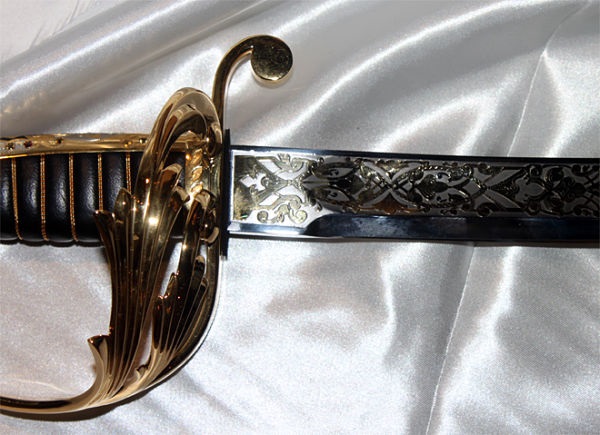
Sword engraving
Aquatint, a type of etching, allows you to create engravings with a wider range of tones. Francisco Goya did a lot for the development of this genre. He is known as the inventor of a system of techniques in this technique. Aquatint remains one of the most difficult techniques in our time. It requires a workshop and a number of tools.
Other techniques
- Mezzotint - another type of metal engraving - allows you to obtain a special depth and velvety tones. This technique is also used to produce color printing. The technique was invented in the 17th century. The artists Johann Pichler, John Farber and an outstanding artist of the 20th century worked there. Maurits Cornelius Escher.
- Drypoint, unlike etching, does not require engraving or etching. Strokes are applied not only with steel, but also with a diamond cutter. The softness and unusualness of the impression is given by the barba - a groove with burrs. Rembrandt and Durer worked in this technique (along with other genres of engraving). Many artists of the 20th century practiced the drypoint technique: Max Beckman, Milton Avery, David Milne, etc.
- Mederite is a metal engraving that became famous in Belarus in the 17th-18th centuries. The metal was etched with nitric acid. Mederite was used in cartography and book publishing.
- Several other techniques are known, for example, soft varnish, lavis, reserve. Some artists work in mixed media, which allows them to create their own unique style.
Engraving continues to attract artists in our time. Today, laser and electromechanical engraving are common. There are a number of workshops that specialize in performing work using this technique.
Engraving with chisel- one of the main types of in-depth engraving on metal.
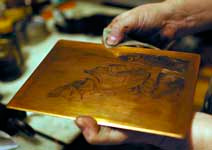
The technology for creating incisive engraving is as follows: a pattern in the form of combinations of lines and dots is deepened in a metal plate (copper, brass, zinc, iron) by mechanical or chemical means.
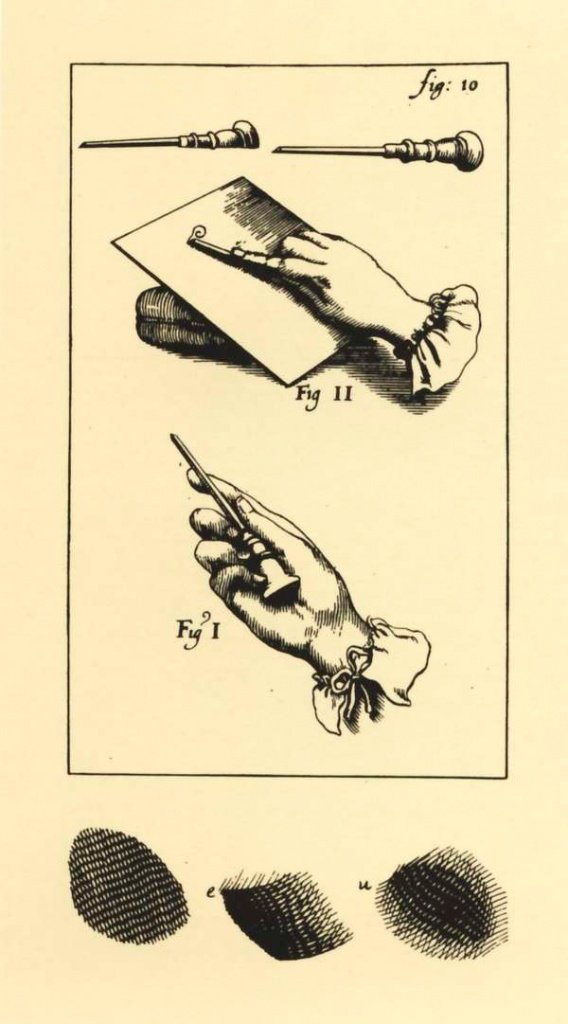
Then paint is driven into the recesses with tampons,
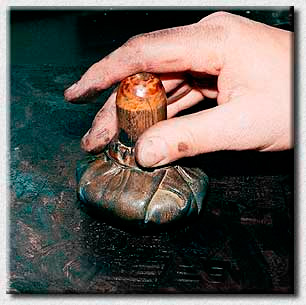
The board is covered with damp paper and rolled between the rollers of the printing press.
Chisel engraving appeared in the first quarter of the 15th century. The first dated burin engraving dates back to 1446. It was long believed that the inventor of this technique was the Florentine goldsmith Maso Finiguerra, whose first engraving dates back to 1458; but this theory was disproven. Today, the oldest engraving on copper is considered to be “The Flagellation of Christ,” made by an unknown German master in 1446. When performing a chisel engraving, the master takes an evenly forged and carefully polished metal board, onto which he applies a drawing using a jewelry punch,
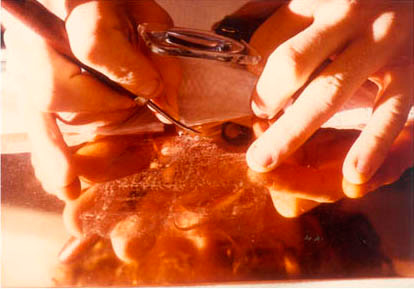
Which is then passed through with a more thorough tool - a cutter or a graver.
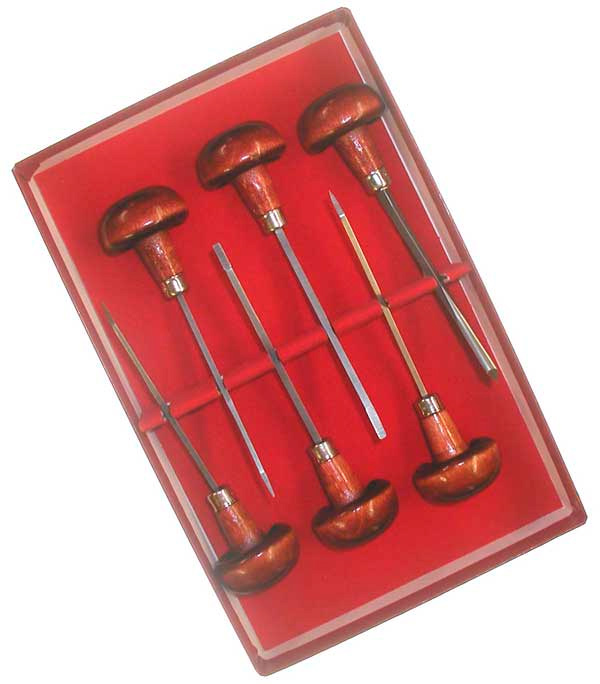
After this, paint is rubbed into the board, the excess is removed, and the sheet is printed.
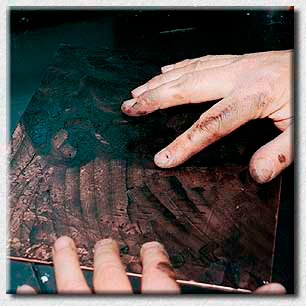
This method allows you to work only with combinations of pure lines. Metal engraving is a complex technique; it requires precision, internal discipline, significant physical effort and many hours of work. So, his famous engraving "Knight, Death and the Devil" relatively small format (24.7×18.9 cm) A. Dürer engraved more three months, not counting the time spent on preliminary production of sketches.
To test the effect of a design, artists often make so-called test prints before the work is completed. Proof prints by outstanding masters are highly valued primarily for their rarity, but perhaps no less for their freshness, for the opportunity to gain insight into the artist's work process. In the process of working on an engraving, the artist often changes the drawing and composition, destroys some lines and replaces them with others, distributes light and shadows differently, etc., and records these successive changes in a number of prints. Such prints (there are up to ten or even more of them), which seem to state the evolution of the engraving, are called “states”. There are also prints “before the signature” (of the artist) and “before the address” (of the publisher). The difference in price between the first and last prints can be very large. In addition, during the work, some artists make light sketches in the margins (something like a “test of the pen”, capturing a suddenly flashed vision of fantasy). These “remarks” recorded in the test prints are then destroyed.
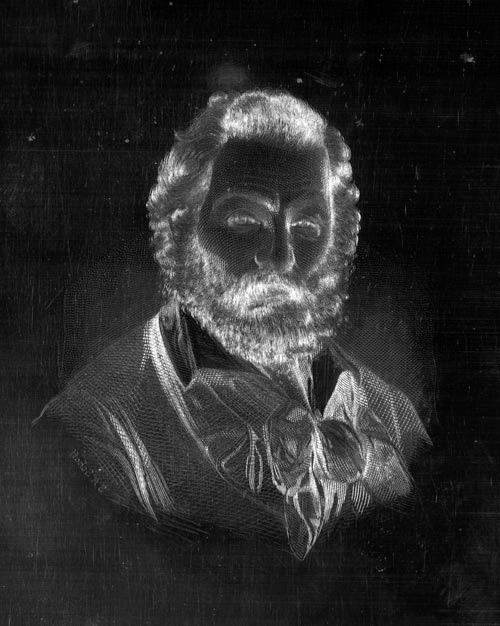
Printing form of incisive engraving. Portrait of Walt Whitman. 1860
The most remarkable master of the 15th century is the German engraver Martin Schongauer, who worked in Colmar and Breisach. His work, combining late Gothic and early Renaissance, had a significant influence on German masters, including Albrecht Dürer. Among the masters of the first half of the 16th century, it is worth noting the unique Dutchman - Luke of Leiden. Of the Italian masters of the 15th century, the most significant are Andrea Mantegna and Antonio del Pollaiolo. In Italy in the 16th century, a direction arose that predetermined an important milestone in the development of European engraving - it was the reproduction of works of painting.
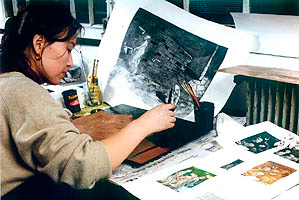
The emergence of reproduction engraving is associated with the name of Marcantonio Raimondi, who, working until the end of the first third of the 16th century, created several hundred reproductions of works by Dürer, Raphael, Giulio Romano and others using a chisel. In the 17th century, reproduction engraving was extremely common in many countries - in Flanders, where many paintings were reproduced, especially by Rubens. And in France at this time, Claude Mellan, Gerard Edelinck, Robert Nanteuil and others contributed to the flourishing of the art of reproduction classical engraved portraits.


